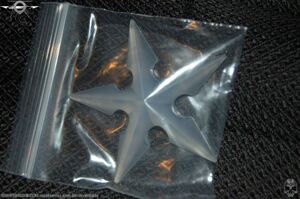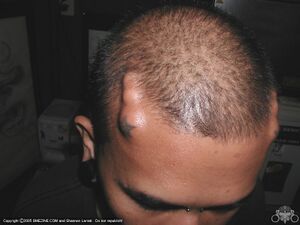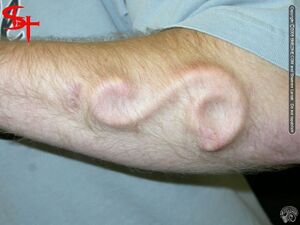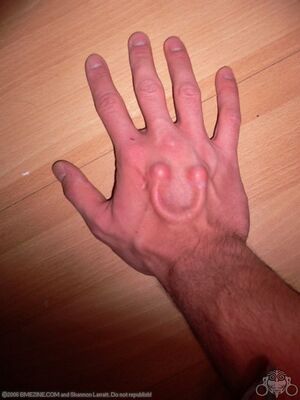Subdermal Implant
Implantation of three-dimensional objects under the skin.
A subdermal 3D-Art implant is any object implanted fully under the skin for the purpose of affecting a sculptural change of the surface. Implants of this type were initially invented and popularized by Steve Haworth.
Implants can be stretched just like piercings. A good example of this are horn implants—they start as smaller implants, and are then taken out when healed and replaced with slightly larger ones. This process is repeated to achieve the final size. There are some risks of irritation to the skin above the implant if this process is pushed too fast, as with all Stretching.
Placement
Careful placement relative to anatomy can minimize Migration, as can careful creation of the insertion pocket (it will affect the implant's ability and motivation to move a great deal). A pressure bandage holding the implant in place may help for the first few days, as will taking care not to sleep on the implant (which would push it out of place). In any case, some degree of migration should be expected.
Procedure
However, the majority of implants are inserted using a pseudo-surgical method. Using a scalpel, a single incision is made. Through that incision a "pocket" is opened with the aid of a dermal separator (essentially a tiny spatula). Different spatula designs of varying shapes and sharpnesses are used depending on the area. A Scalpel is not sufficient for creating this pocket, as it cannot easily be stopped from cutting through the Skin layers rather than simply separating them. The implant is inserted into this pocket, and the incision is closed either with sutures or suture tape.
It should be noted that the incision need not be placed immediately next to the implant location (some breast implant procedures are done through the navel), since the implant can be placed through a "tunnel". For example, in the case of an eyebrow implant, the incision can be made at the top of the forehead behind the hairline. Other than incision placement, incisions should be made with the grain of the Skin, and should be treated gently during healing.
On top of the obvious risks associated with invasive surgical procedures, if an Injectable anesthetic is used, it can carry significant risks as well: for example, anesthetic allergies, Adrenaline excitement, and similar problems. If the practitioner is using this anesthetic illegally or in a non-medical environment, it is likely that they will not have sufficient support to handle these complications, putting your life at serious risk. Adrenaline (also known as epinephrine) allergic reactions, though extremely rare, do have the potential to become fatal. If an allergic reaction is suspected, contact a physician immediately!
Adrenaline-containing injectable anesthetics (such as Lidocaine, marketed under the trade name Xylocaine) should be avoided by people with heart conditions and panic or anxiety disorders. If you have one of these conditions, tell your dentist, too!
Healing and Aftercare
Implants are generally rather trouble-free healing, since they are sealed totally inside your body. Assuming that you have no reaction to the bead material, and the implant is properly placed, the best thing you can do to help it heal (and this goes for any modification) is to be in good health and have a strong immune system. This means be rested, eat well, and don't smoke.
In rare cases (usually with either poor initial placement, overly large implants, or implants with vertical points) implants may reject up through the skin. This is very unusual, but when it happens it is almost always irreversible and results in the loss of the implant, as well as sometime significant scarring, both internally and externally.
Materials
Implant materials are usually Teflon(PTFE) or Silicone. Any biocompatible material can, in theory, be used for implants, including metals (implant-grade stainless steels and related alloys; titanium and titanium alloys; and even high-karat gold), along with various synthetic materials (nylons, silicones, teflon, etc.). Organic materials, as well as many polymers that break down under the hard conditions of the body, should be absolutely avoided. Doctors have access to many advanced materials, offering a multitude of options, but the few I've listed above are what non-medical practioners are limited to. This is, in part, because many medical-grade implants are restricted to sale and use by doctors only, but also because there is no reasonable way for a non-medical practitioner to achieve sufficient training to safely use these materials.
If you are interested in using foams and similar implants, you must seek the assistance of a cosmetic plastic surgeon.
Some implanted objects are coated or encapsulated to protect them from the body and vice versa; for example, magnets are coated with silicone and RFID Transponders are encapsulated in glass.
Risks
- Infection
- Tissue Resorption
- Implant Surface Contamination
- Implant Biocompatibility
- Nerve and Muscle Pressure
- allergies
- Mod Before Client
- Migration
- Implant Rejection
- Implant Subdermal Shifting



